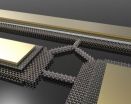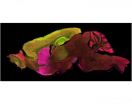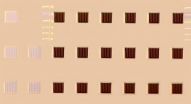(Press-News.org) Junhao Lin, a Vanderbilt University Ph.D. student and visiting scientist at Oak Ridge National Laboratory (ORNL), has found a way to use a finely focused beam of electrons to create some of the smallest wires ever made. The flexible metallic wires are only three atoms wide: One thousandth the width of the microscopic wires used to connect the transistors in today's integrated circuits.
Lin's achievement is described in an article published online on April 28 by the journal Nature Nanotechnology. According to his advisor Sokrates Pantelides, University Distinguished Professor of Physics and Engineering at Vanderbilt University, and his collaborators at ORNL, the technique represents an exciting new way to manipulate matter at the nanoscale and should give a boost to efforts to create electronic circuits out of atomic monolayers, the thinnest possible form factor for solid objects.
"Junhao took this project and really ran with it," said Pantelides.
Lin made the tiny wires from a special family of semiconducting materials that naturally form monolayers. These materials, called transition-metal dichalcogenides (TMDCs), are made by combining the metals molybdenum or tungsten with either sulfur or selenium. The best-known member of the family is molybdenum disulfide, a common mineral that is used as a solid lubricant.
Atomic monolayers are the object of considerable scientific interest these days because they tend to have a number of remarkable qualities, such as exceptional strength and flexibility, transparency and high electron mobility. This interest was sparked in 2004 by the discovery of an easy way to create graphene, an atomic-scale honeycomb lattice of carbon atoms that has exhibited a number of record-breaking properties, including strength, electricity and heat conduction. Despite graphene's superlative properties, experts have had trouble converting them into useful devices, a process materials scientists call functionalization. So researchers have turned to other monolayer materials like the TMDCs.
Other research groups have already created functioning transistors and flash memory gates out of TMDC materials. So the discovery of how to make wires provides the means for interconnecting these basic elements. Next to the transistors, wiring is one of the most important parts of an integrated circuit. Although today's integrated circuits (chips) are the size of a thumbnail, they contain more than 20 miles of copper wiring.
"This will likely stimulate a huge research interest in monolayer circuit design," Lin said. "Because this technique uses electron irradiation, it can in principle be applicable to any kind of electron-based instrument, such as electron-beam lithography."
One of the intriguing properties of monolayer circuitry is its toughness and flexibility. It is too early to predict what kinds of applications it will produce, but "If you let your imagination go, you can envision tablets and television displays that are as thin as a sheet of paper that you can roll up and stuff in your pocket or purse," Pantelides commented.
In addition, Lin envisions that the new technique could make it possible to create three-dimensional circuits by stacking monolayers "like Lego blocks" and using electron beams to fabricate the wires that connect the stacked layers.
The nanowire fabrication was carried out at ORNL in the microscopy group that was headed until recently by Stephen J. Pennycook, as part of an ongoing Vanderbilt-ORNL collaboration that combines microscopy and theory to study complex materials systems. Junhao is a graduate student who pursues both theory and electron microscopy in his doctoral research. His primary microscopy mentor has been ORNL Wigner Fellow Wu Zhou.
"Junhao used a scanning transmission electron microscope (STEM) that is capable of focusing a beam of electrons down to a width of half an angstrom (about half the size of an atom) and aims this beam with exquisite precision," Zhou said.
INFORMATION:
The collaboration included a group headed by Kazu Suenaga at the National Institute of Advanced Industrial Science and Technology in Tsukuba, Japan, where the electrical measurements that confirmed the theoretical predictions were made by post-doctoral associate Ovidiu Cretu. Other collaborators at ORNL, the University of Tennessee in Knoxville, Vanderbilt University, and Fisk University contributed to the project.
Primary funding for the research was provided by the Department of Energy's Office of Science grant DE-FG02-09ER46554 and by the ORNL Wigner Fellowship. The work was carried at the ORNL Center for Nanophase Materials Science user facility. Computations were done at the National Energy Research Scientific Computer Center.
How to create nanowires only 3 atoms wide with an electron beam
2014-04-28
ELSE PRESS RELEASES FROM THIS DATE:
First disease-specific human embryonic stem cell line by nuclear transfer
2014-04-28
NEW YORK, NY (April 28, 2014) – Using somatic cell nuclear transfer, a team of scientists led by Dr. Dieter Egli at the New York Stem Cell Foundation (NYSCF) Research Institute and Dr. Mark Sauer at Columbia University Medical Center has created the first disease-specific embryonic stem cell line with two sets of chromosomes.
As reported today in Nature, the scientists derived embryonic stem cells by adding the nuclei of adult skin cells to unfertilized donor oocytes using a process called somatic cell nuclear transfer (SCNT). Embryonic stem cells were created from one ...
UCLA scientists hunt down origin of Huntington's disease in the brain
2014-04-28
The gene mutation that causes Huntington's disease appears in every cell in the body, yet kills only two types of brain cells. Why? UCLA scientists used a unique approach to switch the gene off in individual brain regions and zero in on those that play a role in causing the disease in mice.
Published in the April 28 online edition of Nature Medicine, the research sheds light on where Huntington's starts in the brain. It also suggests new targets and routes for therapeutic drugs to slow the devastating disease, which strikes an estimated 35,000 Americans.
"From ...
The scent of a man
2014-04-28
Scientists' inability to replicate research findings using mice and rats has contributed to mounting concern over the reliability of such studies.
Now, an international team of pain researchers led by scientists at McGill University in Montreal may have uncovered one important factor behind this vexing problem: the gender of the experimenters has a big impact on the stress levels of rodents, which are widely used in preclinical studies.
In research published online April 28 in Nature Methods, the scientists report that the presence of male experimenters produced a ...
Mount Sinai scientists identify first gene linked to heart muscle disease in children
2014-04-28
Scientists at Icahn School of Medicine at Mount Sinai, along with collaborators at institutions in India, Italy, and Japan, have identified the first gene linked to childhood-onset familial dilated cardiomyopathy (DCM), one of the most common heart muscle diseases in children. It is a progressive and potentially fatal heart condition resulting from an enlarged and weakened heart muscle.
The study, published in Nature Genetics, also revealed a link between DCM and excessive activation of the protein, mTOR. Currently, there are several existing FDA-approved blocking ...
Viral 'parasites' may play a key role in the maintenance of cell pluripotency
2014-04-28
In a study published in Nature Genetics, scientists from the RIKEN Center for Life Science Technologies in Japan, in collaboration with the RIKEN Center for Integrative Medical Sciences, the University of Copenhagen and the Joint Genome Institute (Walnut Creek, California) have discovered that "jumping DNA" known as retrotransposons—viral elements incorporated into the human genome—may play a key role in the maintenance of pluripotency, the ability of stem cells to differentiate into many different types of body cells.
This story is part of a fundamental rethinking taking ...
Researchers identify mechanism of cancer caused by loss of BRCA1 and BRCA2 gene function
2014-04-28
BOSTON – Inherited mutations in the BRCA1 or BRCA2 tumor suppressor genes are by far the most frequent contributors to hereditary cancer risk in the human population, often causing breast or ovarian cancer in young women of child-bearing age. Attempts to test the role that the BRCA genes play in regulating a repair process associated with genome duplication have proven frustratingly difficult in living mammalian cells.
Now investigators at Beth Israel Deaconess Medical Center (BIDMC) report a new mechanism by which BRCA gene loss may accelerate cancer-promoting chromosome ...
Multilayer, microscale solar cells enable ultrahigh efficiency power generation
2014-04-28
Researchers at the University of Illinois at Urbana-Champaign use a printing process to assemble tiny cells into multilayer stacks for extraordinary levels of photovoltaic conversion efficiency.
As an energy source, the Sun has always been a dependable provider. Although it freely shines on everyone, the ability to capture and convert the Sun's abundant energy is anything but free. However, new technologies aimed at achieving "full spectrum" operation in utility-scale photovoltaics may soon make solar energy a viable option.
"A few simple ideas in materials science ...
Overlooked cells hold keys to brain organization and disease, UCSF study shows
2014-04-28
Scientists studying brain diseases may need to look beyond nerve cells and start paying attention to the star-shaped cells known as "astrocytes," because they play specialized roles in the development and maintenance of nerve circuits and may contribute to a wide range of disorders, according to a new study by UC San Francisco researchers.
In a study published online April 28, 2014 in Nature, the researchers report that malfunctioning astrocytes might contribute to neurodegenerative disorders such as Lou Gehrig's disease (ALS), and perhaps even to developmental disorders ...
Loss of Y chromosome can explain shorter life expectancy and higher cancer risk for men
2014-04-28
It is generally well known that men have an overall shorter life expectancy compared to women. A recent study, led by Uppsala University researchers, shows a correlation between a loss of the Y chromosome in blood cells and both a shorter life span and higher mortality from cancer in other organs.
Men have a shorter average life span than women and both the incidence and mortality in cancer is higher in men than in women. However, the mechanisms and possible risk factors behind this sex-disparity are largely unknown. Alterations in DNA of normal cells accumulate throughout ...
Extremes in wet, dry spells increasing for South Asian monsoons, Stanford scholars say
2014-04-28
Stanford scientists have identified significant changes in the patterns of extreme wet and dry events that are increasing the risk of drought and flood in central India, one of the most densely populated regions on Earth.
The discoveries, detailed in the April 28 issue of the journal Nature Climate Change, are the result of a new collaboration between climate scientists and statisticians that focused on utilizing statistical methods for analyzing rare geophysical events. These new approaches reveal that the intensity of extremely wet spells and the number of extremely ...




